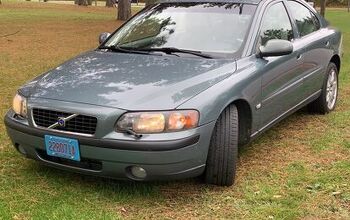GM Zombie Watch 22: International House Of Panic
News that GM is selling a control-shifting single share in GM Shanghai to its Chinese partner SAIC was the toads-from-heaven flourish at the end of an epic week for the RenCen. The day after the last of GM’s lifer CEOs left the building, Opel’s CFO followed suit. One management re-organization and a rough LA Auto Show later, came this symbolic surrender of GM’s largest market for a measly $85m. Accompanied by news that The General would buy out Suzuki’s stake in CAMI for an estimated $46.5m, no less. Oh yeah, and something about India. Freshly-minted CEO and notorious rattlesnake killer Ed Whitacre isn’t about be accused of not trying to shake things up. The only question is where will everything land?
But as apocalyptic as the symbolic handover in China might seem, the India-market gambit was by far the more significant late-week maneuver. SAIC will become the first Chinese firm to establish itself in India, a prospect that Tata, Bajaj and the gold-rushing multinationals have likely been dreading. This alone is no mean feat, considering the deep suspicions between China and India. In essence, it gets to piggyback on GM’s existing GM India infrastructure of dealers and, less helpfully, factories. In return, it will invest some $350m into the venture in hopes of improving on GM’s 65,702 unit sales in 2008.
Ironically, the firm that GM parted ways with on Friday is also the reason for GM’s gambit. Suzuki’s Indian JV, Maruti, sold 711,818 units in India in 2008, and with strong market growth and SAIC investment, GM imagines it can make major inroads on that number. Indeed, GM’s India sales will have to double on the strength of SAIC’s investment to make the deal worthwhile. As a global player, GM has made a momentous decision to share half of its future in one of the world’s most untapped markets. Why then, if GM was willing to walk away from half of India’s future growth, did it not get more free cash (as opposed to Indian-market investment) out of SAIC?
The short answer is that India is seen as the next China: an underdeveloped, underserved market of vast potential. It goes without saying that GM doesn’t have the cash to match Indian offensives by Ford, Renault, Honda, Hyundai, and Toyota, but GM does have a relatively strong position to start from (#5 in sales in 2008). Early entry into China was key to GM’s success in that market, and it surely sees India through the same lens. This influx of foreign competitors has created a gold rush environment that has GM trading in its long-term strategic position for a short-term boost. Unlike those competitors though, GM has more to worry about than merely falling behind in the Indian market.
GM’s global woes, specifically cash influx needed to right its struggling Opel and Daewoo units, are a far bigger threat than mere also-ran status in India. After all, these two divisions are responsible for developing GM’s most successful global products, and should it lose them GM’s status as a global power would become little more than a fading dream. After all, the Buicks that Shanghai GM builds and sells with great success in the Chinese market were developed by Opel. The Cruze, Aveo and Matiz Creative (Spark) that form the backbone of GM’s developing-market (i.e. India) strategy were developed (and in many cases, built) by Daewoo. Without these products and their successors, GM and SAIC’s cooperation will be for naught. So why didn’t this latest flurry of wrangling result in a solution to these crucial divisions’ troubles?
Probably because, even if SAIC’s $350m came as free cash, it wouldn’t even make a dent in the problem. Daewoo lost $2b last year on foreign exchange hedges, and out of credit, it’s staying alive on $413m that GM injected into the firm a few months ago. Opel, meanwhile, needs about $5b for its restructuring, some 20 percent of which GM has said it will contribute to the cause. But the rest of that money will have to come from European governments, an unlikely prospect considering how unloved GM is on the Continent. If the Europeans don’t come through with restructuring aid, GM will have to burn through a good quarter of its government-supplied cash pile in hopes of keeping a division it has admitted it can’t survive as a global player without. And that’s not counting the real amount needed to keep Daewoo developing new products, which could easily be in the billions.
There’s no doubt that GM needed to make faustian bargains to remain a global player, post-bankruptcy. Fritz Henderson’s approach saw Opel as the most expensive and expendable dillema on GM’s plate, and his deal to sell the German division would have represented a major setback to GM’s ambitions. But in calling back the Opel deal, new CEO Ed Whitacre sent the message that Opel’s development capability was too valuable to give up. And so Whitacre made a faustian bargain of his own, in which GM gave up control in China and half of its future in India. Though this deal hurts less in the short-term than seeing Opel become independent, the long-term strategic implications are just as worrying, and more importantly, it does nothing to resolve GM’s underlying global challenges. Fritz’s deal with the devil was an act of necessity, Whitacre’s has the air of a desperate gamble.
Having survived on international profits for decades, it’s ironic that GM’s post-bankruptcy era is being defined by trouble abroad. Moreover, it’s troubling that GM is ceding leadership in the growth markets that have sustained it to its Chinese partners, especially since the deals haven’t created any more certainty or security for The General on the global development front. On the other hand, if GM is stepping back, sustaining its overseas presence by bringing in its Chinese partner, perhaps that same strategy will save the day when GM finally deals with its crumbling cornerstones in Germany and Korea. SAIC was mentioned as a possible partner in the Daewoo rescue, and since its future is so closely tied to GM maybe the cash-rich Chinese firms will take stakes in Opel and Daewoo.
This week’s news is as much the story of SAIC’s rise as GM’s continued decline. With the Chinese government pushing for consolidation in the auto industry, SAIC may see GM as a dying host from which to springboard into international prominence. With half of GM’s mega-market efforts, GM’s Chinese tail need only take stakes in Opel and Daewoo to truly begin wagging the dog. After all, GM’s alternatives to more cooperation with SAIC are expensive, messy and will most likely involve sending taxpayer money overseas. But with pressure for an IPO looming, GM has to get its international house in order. Though this week’s manuevering hasn’t secured GM’s position, it may just point the way towards The General’s Chinese-led future.
(imagine if GM and Suzuki’s ill-fated cooperation had included India in the first place)More by Edward Niedermeyer
Latest Car Reviews
Read moreLatest Product Reviews
Read moreRecent Comments
- Corey Lewis Facing rearwards and typing while in motion. I'll be sick in 4 minutes or less.
- Ajla It's a tricky situation. If public charging is ubiquitous and reliable then range doesn't matter nearly as much. However they likely don't need to be as numerous as fuel pumps because of the home/work charging ability. But then there still might need to be "surge supply" of public chargers for things like holidays. Then there's the idea of chargers with towing accessibility. A lack of visible charging infrastructure might slow the adoption of EVs as well. Having an EV with a 600+ mile range would fix a lot of the above but that option doesn't seem to be economically feasible.
- 28-Cars-Later I'm getting a Knight Rider vibe... or is it more Knightboat?
- 28-Cars-Later "the person would likely be involved in taking the Corvette to the next level with full electrification."Chevrolet sold 37,224 C8s in 2023 starting at $65,895 in North America (no word on other regions) while Porsche sold 40,629 Taycans worldwide starting at $99,400. I imagine per unit Porsche/VAG profit at $100K+ but was far as R&D payback and other sunk costs I cannot say. I remember reading the new C8 platform was designed for hybrids (or something to that effect) so I expect Chevrolet to experiment with different model types but I don't expect Corvette to become the Taycan. If that is the expectation, I think it will ride off into the sunset because GM is that incompetent/impotent. Additional: In ten years outside of wrecks I expect a majority of C8s to still be running and economically roadworthy, I do not expect that of Taycans.
- Tassos Jong-iL Not all martyrs see divinity, but at least you tried.


































Comments
Join the conversation
A new candidate for CEO of GM: Hakan Samuelsson, who just got kicked out of MAN (3rd largest truckmaker in EU) by everyone's favorite villain, Ferdinand Piech.
Where, exactly, is the tip-over point, beyond which US taxpayers would have been better off to let GM go tango-uniform? If we ain' there yet, it's gotta be soon.... We are heading into an economic ice-age, metaphorically speaking.....and GM is the Mastodon....big, ponderous and clueless.....that'll be frozen in the glacier.